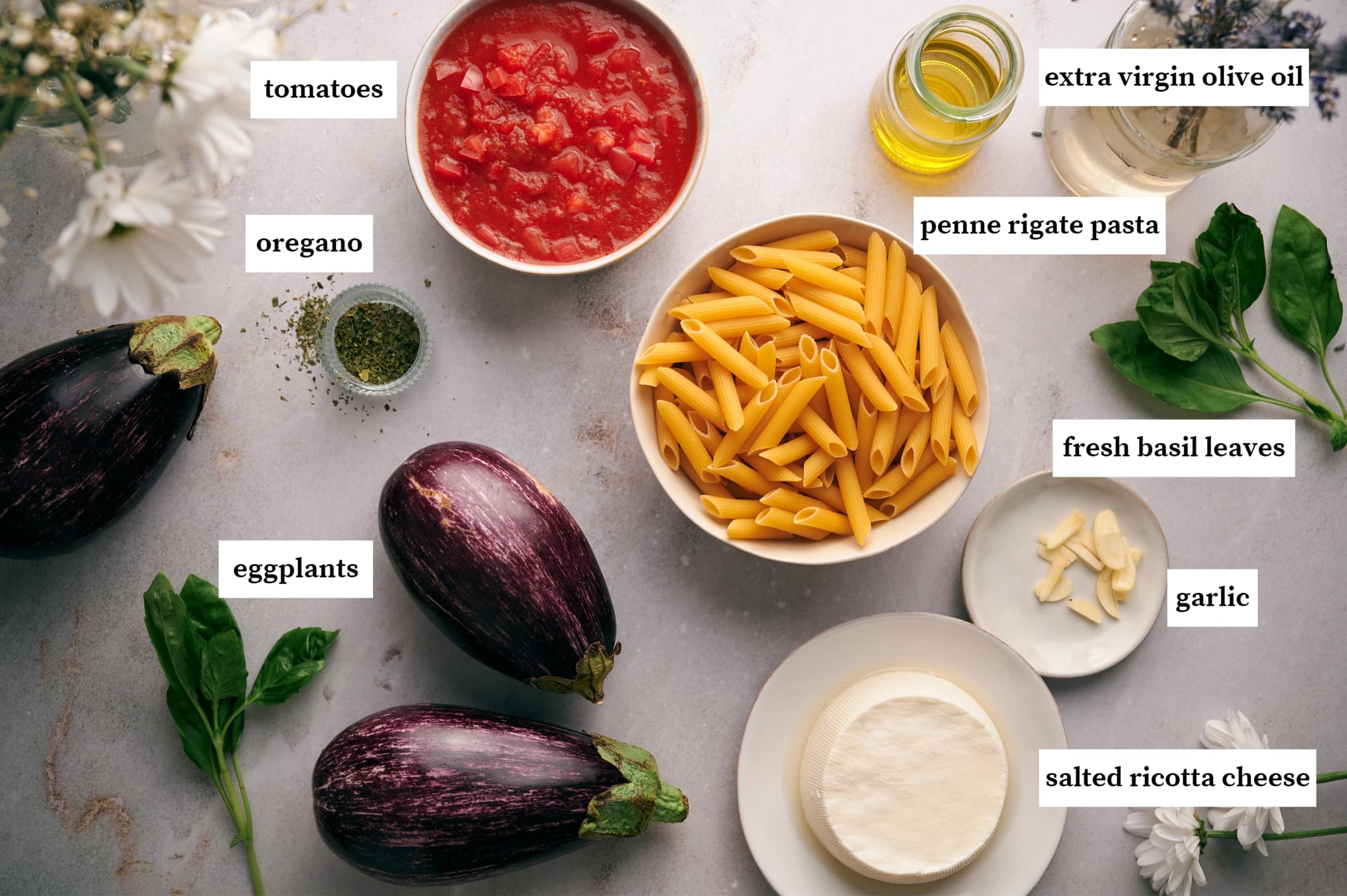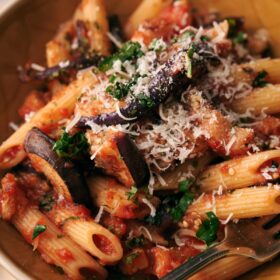One of the most well-loved Sicilian pasta dishes has a strange name, “Norma.” This recipe is perfect for meatless Monday cooking and takes less than an hour to make.

No, this dish isn’t named after an old Italian nonna, rather it’s believed to have been named after Vincenzo Bellini’s tragic opera of the same name. It is said that the playwright Nino Matroglio, a native of the Sicilian city of Catania, exclaimed that the tasty eggplant pasta dish was a masterpiece just like the famous opera.
While the name pasta alla Norma may be a bit odd, the flavors are not. The simpler name, pasta alle melanzane e pomodoro (pasta with eggplant and tomatoes) tells you what you can expect to find in your plate.
Bringing together fresh Italian tomatoes, creamy and savory fried eggplant, and salty ricotta, you end up with a pasta sauce that is perfect for any warm summer evening.
Pasta alla Norma does not require any special equipment to make. You simply need:
If you know anything about Sicilian cuisine, you probably know that this classic Sicilian dish and all the other recipes from the island start with one important thing: amazing, fresh ingredients. In fact, the quality of the ingredients is always the top priority when making Sicilian classic recipes. Here is a list of what you’ll need to make pasta alla Norma:

First, slice the eggplant into ½-inch thin slices (photo 1), sprinkle with salt, and leave “drain” for 30 minutes. Pat dry well with paper towels (photo 2).

Next, add extra virgin olive oil to a large pan over medium heat and when it is hot add the eggplant slices several at a time to lightly fry, turning to cook evenly (photo 3). Sprinkle with oregano as they cook. Both sides should be golden brown. Remove and set on a plate.

Now that all the remaining eggplant is cooked, add it all back into the pan with the garlic (photo 4) and turn down the heat. When the garlic is cooked add the tomatoes and simmer for 15 minutes (photo 5).

Put a large pot of water with kosher salt on to boil. Cook the pasta following the package instruction for al dente (photo 6). Set aside a cup of the water the pasta was cooked in before draining the pasta well.
Add basil, salt, and pepper to taste the sauce (photo 7), and then pour it over the pasta and toss (photo 8), you can add pasta water if necessary if the pasta sauce is too thick.

Plate the pasta and add some food styling touches like fresh basil leaves or fresh parsley and then grate ricotta salata on top.

At its base, this dish is a simple sauce of crushed tomatoes with cooked eggplant tossed with a short pasta such as macaroni or penne with a bit of salty ricotta salata cheese.
If you want to reduce the calorie count of the dish, instead of frying you can grill or roast the eggplant slices, though it won’t be quite the same. Roasted eggplant has an earthier flavor, but the traditional recipes stick to frying the eggplant in extra virgin olive oil.
Outside of Sicily, you will find a great deal of creativity, even to the point of including shrimp and other vegetables. But we believe that, as with most dishes in Southern Italian cuisine, simplicity is best. Just take care to use only high-quality ingredients and it will be hard to go wrong with this satisfying vegetarian dinner.
Most of us can conjure up some bad eggplant dishes we’ve tasted in the past with soggy, gummy, or bitter eggplant that has ruined the entire taste of the pasta dish. Luckily, this is avoidable by following a few easy steps.
We recommend cutting the eggplant into thick slices, as described in the recipe, and then laying them out with a sprinkling of coarse salt on top for at least half an hour.
This allows them to drain away any bitter flavor that could be present. After the eggplant slices have released their bitterness, you simply have to rinse off the eggplant and gently pat it dry so it’s ready to fry. Avoid at all costs placing wet eggplant into hot oil as it will splatter!
Try other simple pasta recipes:
If you choose to grill the eggplant instead of frying it, we recommend removing the eggplant and only adding it back into the tomatoes after they are almost fully cooked to prevent the eggplant from breaking down too much.
Another alternative is doing roasted eggplant by cutting it into small eggplant cubes, tossing in olive oil, sprinkling it with salt, and then roasting at 400° F until tender and golden brown. The roasted eggplant should be added to the dish at the same time as you would add the fried eggplant.
These can also be added with the garlic if you like a little spiciness to the dish and it is often added in traditional recipes.
For a faster version of the dish, start with oil and add garlic, and then add cubed eggplant and tomatoes at the same time. This preparation technique will be less flavorful but can be ready in just about the time it takes to boil the pasta.
Pasta alla Norma is a bright and summery pasta dish recipe, full of acidic tomato sauce and creamy fried or roasted eggplant. It goes very well with Southern Italian white wines, namely Falanghina and Greco di Tufo, or any Sicilian white you might find; an aromatic Sauvignon Blanc can be a great choice.
If you absolutely must have red wine with this recipe, pass up the Chianti and instead grab a Sicilian red from the mountainside vineyards of Sicily’s still active Volcano, Mount Etna. You’ll find these wines under the Etna Rossa name, and they have a richness that will go nicely with the eggplant while having the acidity to stand up to the tomato sauce. Plus, it’s a wine from the region where the recipe was created, that’s always a win!
Ricotta salata is not the same thing as ricotta. Technically, it starts out the same, but ricotta salata is pressed to remove the majority of the liquid and then aged for at least 3 months to dry it out further. Salata means salty because this cheese has a more concentrated and intense salty flavor than its mild, fresh version. It is great for grating over pasta.
Yes, leftovers of pasta alla Norma are yummy. The pasta can be stored in an airtight container for a day or two but we don’t recommend freezing as both the pasta and eggplant turn into mush when defrosted. Consider not adding the basil and cheese to all the pasta when originally making it and just adding these items once plated. By doing this you can add these items fresh to perk up the dish when reheating it the next day. Baking it in the oven with a sprinkling of ricotta salata cheese is also a way to reheat.

love ur recipes – my husband is Sicilian, me, well I’m 1/2 Tuscan and 1/2 Abruzzo. Please keep them coming!
Glad you are enjoying them. Grazie mille Loretta!
Oh so good!
Grazie!